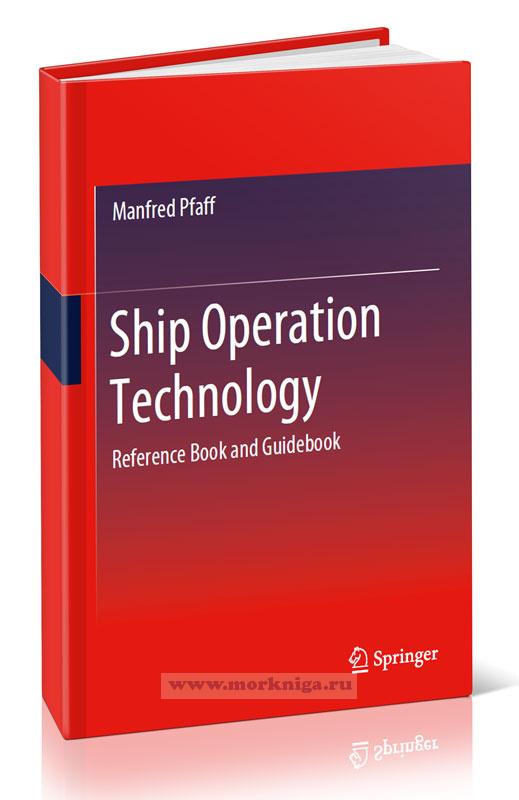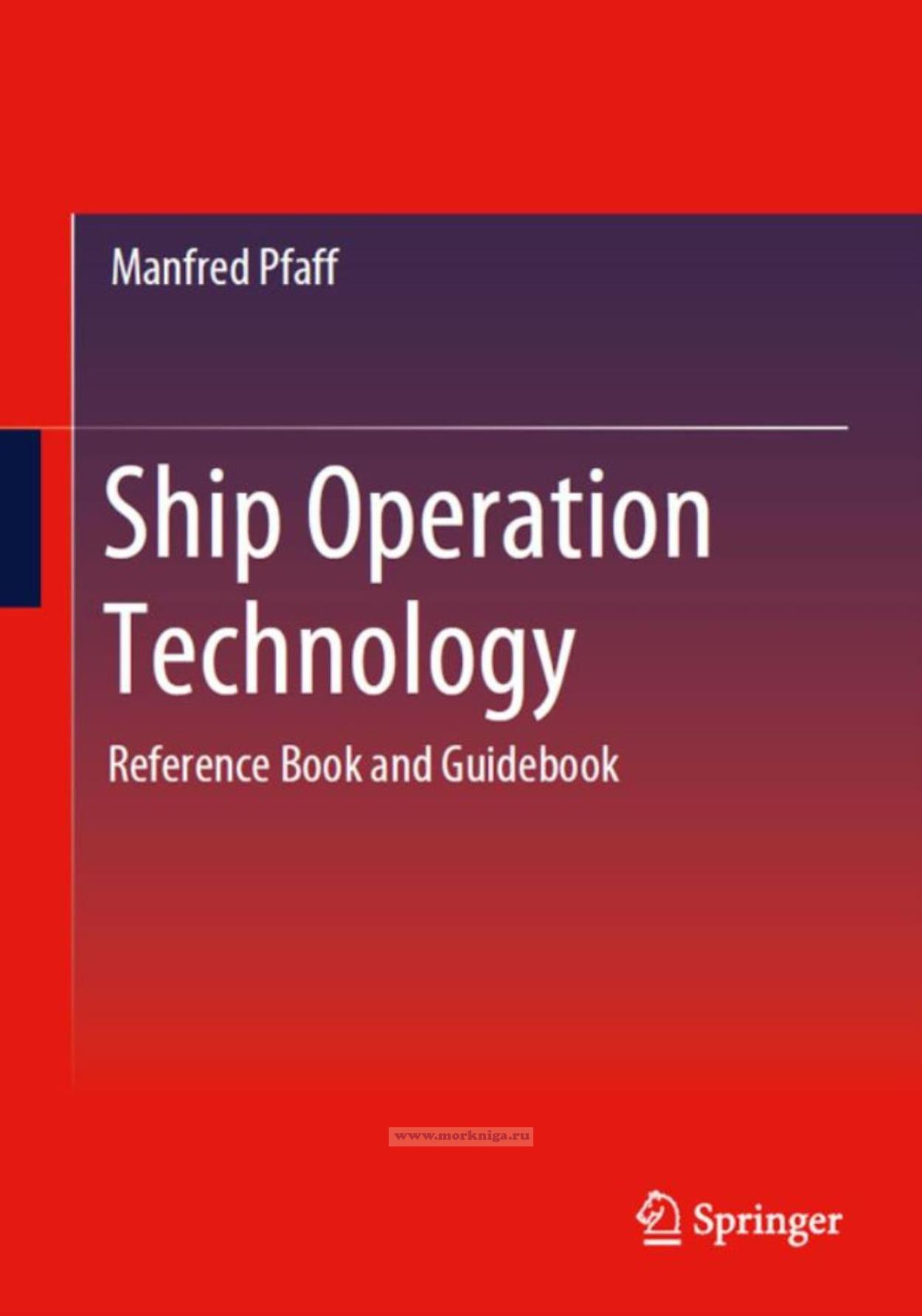Ship Operation Technology. Reference Book and Guidebook/–Ґ–µ—Е–љ–Њ–ї–Њ–≥–Є—П —Н–Ї—Б–њ–ї—Г–∞—В–∞—Ж–Є–Є —Б—Г–і–Њ–≤. –°–њ—А–∞–≤–Њ—З–љ–Є–Ї –Є –њ—Г—В–µ–≤–Њ–і–Є—В–µ–ї—М
–Ш–Ј–і–∞–љ–Є–µ –љ–∞ –∞–љ–≥–ї–Є–є—Б–Ї–Њ–Љ —П–Ј—Л–Ї–µ
On January 1, 2015, the world merchant fleet comprised 50,422 ships with >300 GT and a deadweight tonnage of 1661 million dwt. Bulk carriers formed the main part of this, followed by crude oil tankers.
To ensure that these ships can navigate the worldвАЩs oceans safely, a functioning ship operation technology is of particular importance.
In addition to a few brief explanations of shipbuilding and the basics of the various propulsion systems, this textbook вАЬShip Operation TechnologyвАЭ deals with auxiliary systems and auxiliary machinery, power units, life-saving equipment, ship safety, and much more - in other words, with what makes the hull into a ship in the first place. In this respect, this book complements other literature dealing with the actual design and construction of ships and with the propulsion technology of ships.
Contents
1 Job Description of the Ship Operation Technician
Reference
2 Rules and Regulations
2.1 Hierarchy of Laws and Standards
2.2 International Law Regulations
2.2.1 SOLAS
2.2.2 MARPOL
2.2.3 Collision Avoidance Rules
2.3 European Union regulations
2.4 German Laws and Regulations
2.5 Construction Regulations of the Classification Societies
2.6 Technical Standards
References
3 Hulls, Cordage, Superstructures, Anchor Gear, Corrosion Protection, and Deck Coverings
3.1 Hull
3.1.1 Buoyancy and Stability
3.1.2 Important Designations and Principal Dimensions
3.2 Superstructure, Deckhouse, Chimney
3.3 Nonintegrated Foundations
3.3.1 Excursus on Vibrations
3.4 Anchor Gear, Lines, and Cordage
3.4.1 Anchor Gear
3.4.2 Design or Dimensioning of Anchor and Chain
3.4.3 Line and Cordage
3.4.4 Bollards
3.5 Ladders, Stairs, Railing
3.5.1 Ladders
3.5.2 Fixed Ladders
3.5.3 Stairs
3.5.4 Railing
3.6 Corrosion Protection and Deck Coverings/floors
3.6.1 Corrosion Protection
3.6.2 Deck Coverings/Floors
References
4 Propulsion Systems
4.1 Introduction
4.2 Ship Resistance
4.2.1 Economic Aspects of Shipping
4.2.2 Examples From Nature
4.2.3 Fluid Mechanical Considerations on the Hull
4.2.4 The Effect of Bulbous Bow on Tow Resistance
4.2.5 Required Propulsion Power
4.2.6 Summary
4.3 Power Generation
4.3.1 Internal Combustion Engines
4.3.2 Gas Engines
4.3.3 Turbines
4.3.4 Electric Propulsion
4.3.5 Fuel Cell Propulsion
4.3.6 Sail Propulsion
4.4 Power Transmission
4.4.1 Direct Propulsion
4.4.2 Propeller
4.4.3 Propulsion Shaft Assembly
4.4.4 Stern Tube Seal
References
5 Ship Operating Systems/Auxiliary Systems
5.1 Steering Gear
5.1.1 Size of the Rudder Area
5.1.2 Calculation of the Rudder Force and Rudder Moment
5.1.3 Kort Nozzle
5.2 Stabilization Systems
5.2.1 Introduction
5.2.2 Bilge Keels
5.2.3 Fin Stabilizers
5.2.4 Roll Damping Tanks
5.3 Heel Compensation and Ballast Water Systems
5.4 Pumps, Pipelines, and Fittings
5.4.1 Pumps
5.4.2 Pipelines and Fittings
5.5 Heat Exchanger
5.5.1 Introduction
5.5.2 Types of Heat Exchangers
5.5.3 Construction of Heat Exchangers
5.5.4 Characteristics of Heat Exchangers
5.6 Refrigeration, Ventilation and Air-Conditioning Technology, Heating Systems
5.6.1 Refrigeration
5.6.2 Ventilation and Air-Conditioning Systems
5.6.3 Heating Systems
5.7 Fresh and Drinking Water Production
5.7.1 Introduction
5.7.2 Fresh Water Production by Evaporation
5.7.3 Fresh Water Production by Reverse Osmosis
5.7.4 Treatment of Drinking Water
5.7.5 Drinking and Hot Water System
5.7.6 Bunkering of Drinking Water
5.8 Transshipment Facilities
5.8.1 Board Cranes
5.8.2 Handling of Bulk Cargo
5.8.3 Vehicle Ramps on Ferries
5.8.4 Tankers
5.8.5 RAS Device
5.8.6 Passenger Ships: Gangway/stelling
References
6 Onboard Power Supply and Electrical Circuit Examples
6.1 Introduction
6.2 Onboard Electricity Generation
6.2.1 Generators
6.3 Shore-Side Power Supply
6.3.1 Background
6.3.2 Technology of Shore-Side Power Supply
6.4 The Electrical System
6.5 Electrical Circuit Examples
6.5.1 Switch-off
6.5.2 Alternating Circuit
6.5.3 Motion Detector
6.6 Electronic Circuits
References
7 Occupational Safety and Ship Safety, Fire Protection
7.1 Occupational Health and Safety, Safety at Work, and Ship Safety
7.1.1 SOLAS
7.2 Fire Protection
7.2.1 Introduction
7.2.2 Introduction to Fire Training
7.2.3 Structural Fire Protection, Requirements for Components and Materials
7.2.4 Fire Detection and Alarm
7.2.5 Firefighting Equipment and Installations
7.2.6 Firefighting by Firefighting Teams
7.3 Safety Marking at the Workplace, Ship Safety Guidance System
7.3.1 Safety Marking at the Workplace
7.3.2 Safety Guidance System
7.4 Bilge Pumping Systems
7.4.1 Introduction
7.4.2 Essential Requirements, Design Notes
7.5 Navigation Equipment, Light Guidance, Radio
7.5.1 Navigation Facilities
7.5.2 Light Guidance
7.5.3 Radio Equipment
7.6 Survivability of Warships
References
8 Environmental Protection in Maritime Transport
8.1 Maritime Environmental Legislation
8.2 Possible Environmental Damage
8.2.1 Contamination by Oil
8.2.2 Pollution from Ship Sewage
8.2.3 Pollution by Ship-Generated Waste
8.2.4 Air Pollution by Ship Exhaust Gases
8.2.5 Carryover of Organisms by Ballast Water
8.3 Technical Measures for Marine Environmental Protection
8.3.1 Waste Management on Board
8.3.2 Exhaust Emissions of the Propulsion and EDiEng Systems, Liquefied Natural Gas (LNG) Propulsion
8.4 Wastewater Management
8.4.1 Introduction
8.4.2 Discharge Regulations for Ship Sewage According to MARPOL Annex IV
8.4.3 Wastewater on Board
8.4.4 Wastewater Storage
8.4.5 Wastewater Treatment Plants
8.4.6 Assessment of Existing Technologies with Regard to Their Achievable Discharge Values
8.5 Bilge Water Treatment
8.5.1 Bilge Water Treatment Plants
8.6 Ballast Water Treatment
8.6.1 Introduction
8.6.2 Ballast Water Exchange
8.6.3 Ballast Water Treatment
References
Tables, Diagrams, and Overviews
Index

